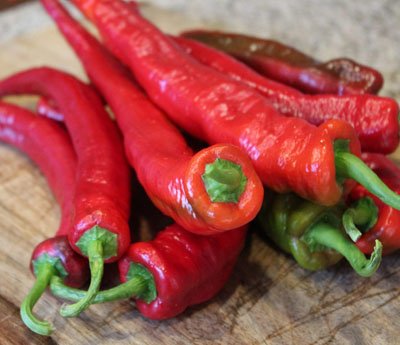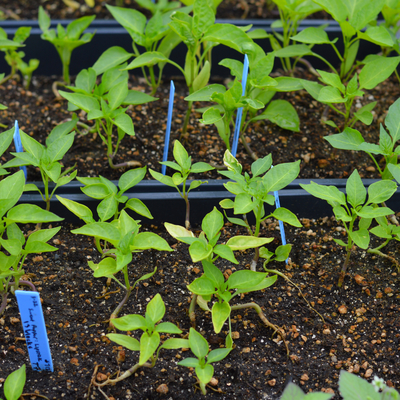Getting a Jump on Peppers: Three Strategies to Consider
by Janet Scheren, Fairfax Master Gardener
 Pepper plants are native to Central and South America and thrive in hot, sunny and humid environments. It’s not surprising that pepper seeds need soil temperatures between 70 to 80 degrees (21 to 26° C) to germinate. Air temperatures should hover between 70 and 80 degrees (21 to 26° C) during the day and above 55 degrees (12° C) at night for the plants to thrive and produce. To complicate matters, pepper plants typically require between 55 to 90 days after germination to produce ripe fruit.
Pepper plants are native to Central and South America and thrive in hot, sunny and humid environments. It’s not surprising that pepper seeds need soil temperatures between 70 to 80 degrees (21 to 26° C) to germinate. Air temperatures should hover between 70 and 80 degrees (21 to 26° C) during the day and above 55 degrees (12° C) at night for the plants to thrive and produce. To complicate matters, pepper plants typically require between 55 to 90 days after germination to produce ripe fruit.
My initial attempts to grow peppers from seed in my Zone 7 garden resulted in major frustration. At the end of the growing season with frost fast approaching, my best plants grown from seed outdoors had unripe green fruit, but most were only just starting to produce fruit. The second year due to a milder spring, I got an earlier start and added a few varieties with a shorter growing season. Unfortunately, I still wound up with lots of unripe peppers at season’s end.
At this point I had found several peppers I actually wanted to grow in my garden and was determined to develop strategies not only to wind up with ripe fruit during the growing season, but to grow sufficient peppers to actually do something with them. Peter Piper picking a “peck of pickled peppers” came to mind. While you have to pickle the peppers yourself, I did actually want a peck — 2 gallons — of peppers or more to pickle. My favorite had become pepperdew peppers, also known as peppadew peppers. I found a wonderful South African recipe that produced the perfect combination of heat and sweetness to delight most palates. So I set off to grow a bunch of them — along with pimento peppers, banana peppers and some red sweet peppers.
The easy hack is to buy plants from nurseries that have already started producing fruit. The main limitation here is that nurseries typically stock only a few varieties. My favorite online seed source for peppers featured more than 300 varieties!

Pepper Seedlings
I added two additional strategies to my arsenal that third year. I took advantage of the fact that peppers are tender perennials. In areas that are frost free, peppers grow from year to year, developing stronger root systems, and thus producing larger fruits and harvests earlier in the year. So at the end of the previous growing season, I cut back my two strongest peppadew pepper plants, dug them up and transplanted them to pots. You’ll notice that pepper plants have a Y fork in their stem. Prune back to about 6 inches (16 cm) or so above the Y. Then dig around the plant with a sharp spade to the approximate size of pot to fill. You may need to root prune a bit more or add additional potting soil to fill the pot. Next you’ll need to water the plant and find a cool spot between 50 to 60 degrees (10 to 15° C) with moderate light to over winter. Water the plants sparingly every two weeks or so. While dormant, pepper plants need much less water than when growing. In spring after the last frost, they are ready to dig back into your garden.
Alternatively, you can actively grow peppers over the winter under grow lights. These plants will have more foliage and be ready to produce earlier, but they require more care and water. Check them frequently to be sure they don’t dry out.
As a fall back, I also use my grow lights to start plants from seedlings beginning in mid-March. Check your grow lights to be sure they are rated for producing fruit. There are many strengths of lights. Some will just support seedling growth, but do not offer enough wattage to bring plants to flower or fruit.
References
Growing Peppers in the Home Garden, Ashley Kulhanek, Agriculture and Natural Resources, Medina County and Brian Kleinke, Agriculture and Natural Resources, Franklin County, Ohio State University Extension
Growing Peppers in Home Gardens, Marissa Schuh and Cindy Tong, University of Minnesota Extension